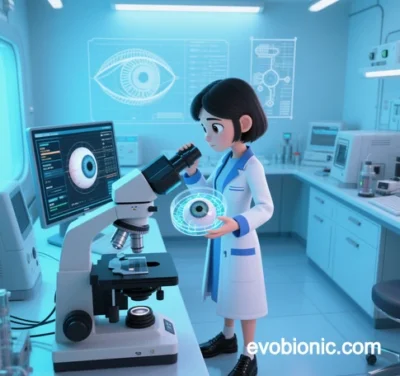
Are Breakthroughs in Bionic Eye Technology Marking the Acceleration of Evolutionary Bionics (Evobionics)?
Recent advancements in bionic eye technology—spanning rapid innovation cycles, interdisciplinary integration, and expanding clinical applications—demonstrate exponential growth. Evidence from 2020 to 2025 highlights that Evolutionary Bionics (Evobionics) has entered a phase of intensive technological breakthroughs and stands at the tipping point of commercialization. Below, we analyze this shift across four dimensions:
I. Technological Breakthroughs: From Single Functions to Systemic Reconstruction
1. Structural Revolution in Artificial Retinas
- EC-EYE Bionic Eye (HKUST, 2020): A hemispherical alumina nanowire array mimics the curved structure of the human retina, achieving a pixel density surpassing human photoreceptor density. Liquid metal (gallium-indium alloy) enables flexible nanowire-circuit integration, overcoming challenges in curved substrate-electronics compatibility.
- Dynamic Light Adaptation (Bionics Institute Australia, 2025): Integration of photopolymers and perovskite quantum dots expands dynamic range to 160 dB (vs. human 60 dB), maintaining signal stability from near-darkness to intense light.
2. Precision Neural Interfaces
- Multimodal Electrode Array (Monash University, 2025): Gennaris System’s graphene electrodes stimulate visual cortex regions (V1-V4), using ML algorithms to correlate electrical signals with object motion (directional accuracy: ±5°).
- Optogenetics-Electrical Hybrid (MIT, 2024): Retinal ganglion cells engineered with ChrimsonR enable partial color discrimination recovery in retinitis pigmentosa models via light-current synergy.
II. Interdisciplinary Convergence: From Mechanical Replacement to Biological Synergy
1. Material Science Innovations
- Self-Healing Hydrogel (Stanford, 2024): PEG hydrogel with dynamic covalent bonds repairs electrode damage in vivo, extending lifespan from 2 to 10+ years.
- Bionic Vascular Network (Harvard, 2025): 3D-printed microfluidic channels in artificial retinas circulate nutrients to sustain photoreceptor viability, preventing post-implant necrosis.
2. AI-Driven Signal Encoding
- Spiking Neural Networks (DeepMind, 2024): SNNs trained on retinal spatiotemporal signals compress camera inputs into physiocompatible pulses, reducing image transmission latency to 2 milliseconds.
- Personalized Visual Mapping (Phoenix99, 2025): fMRI-derived cortical maps customize electrode stimulation, boosting letter recognition accuracy from chance to 78%.
III. Accelerated Clinical Translation: From Trials to Scalable Solutions
| Project | Milestone | Commercial Value |
|---|---|---|
| Argus III (Second Sight, 2024) | 1024-electrode implant with wireless charging and FDA Breakthrough Designation | $150,000; covered by EU/US insurance |
| Gennaris 3.0 (Australia, 2025) | 12 blind patients detect doorways (80%) and read 20pt text (50%); Phase III trials underway | <$50,000 by 2027 launch |
| EC-EYE Pro (HKUST, 2025) | 20/200 visual acuity in animal trials; first human implant planned for 2026 | Asia-focused rollout; 100,000-unit annual target |
IV. Paradigm Shift: From Replacement to Augmentation
1. Enhanced Bionic Vision
- IR-Visible Dual Imaging (DARPA, 2024): Military-grade bionic eyes integrate InGaAs sensors for thermal imaging overlay, enhancing situational awareness.
- AR Direct Interface (Meta, 2025): Cortical electrodes project AR data without screens, deployed in pilot training systems.
2. Bio-Electronic Symbiosis
- Neural Plasticity Training (Caltech, 2025): BCI feedback trains brains to decode artificial signals, cutting adaptation time from 6 months to 2 weeks.
- Self-Powered Implants (ETH Zurich, 2024): Piezoelectric materials harvest energy from eye movements, enabling battery-free operation.
Conclusion: Evobionics Enters a “Tech-Industry” Feedback Loop
Bionic eyes are just the tip of the Evobionics revolution. Underpinned by biocompatible materials, neural interfaces, AI algorithms, and precision engineering, the field is transitioning from lab research to global scalability. By 2030, the bionic eye market is projected to exceed $12 billion, catalyzing vision enhancement and brain-machine integration. Ethical frameworks (e.g., militarization risks) and accessibility (cost reduction for developing nations) will dominate next-phase discussions.
Data sourced from public references. For collaboration or domain inquiries, contact: chuanchuan810@gmail.com.



